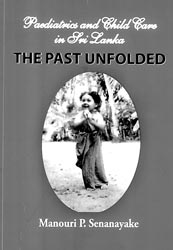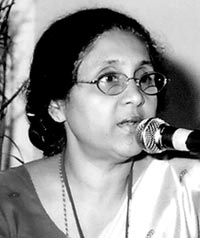
The birth and growth of child carePaediatrics and Child Care in Sri Lanka, The Past Unfolded by Manouri P. Senanayake. Vijitha Yapa Publications.
When Prof. Manouri Senanayake was a little girl, she would listen to her father, obstetrician Dr. P. Dissanayake relating stories of the medical scene of yesteryear. He was among the first batch of medical students who worked with Prof. C. C de Silva, the first professor of paediatrics appointed in this country in 1949 and it was shortly after his death that those ‘old stories’ sowed the first seeds in her mind for a book that would document the history of paediatrics in this country. “Paediatrics is seventy years old in this country,” she says, for this was reason enough to record the significant milestones along the way. As a paediatrician herself with a particular fondness for history, she was no doubt, eminently qualified for the task. Her book ‘The Past Unfolded: Paediatrics and Child Care in Sri Lanka’ launched this Thursday, goes back in time from antiquity through the days of the ancient kings to modern times. It was in 1892 that the first woman doctor, Dr. A. Van Imgen arrived in the country and charged with looking after the women patients, took the decision to separate the children from the adults and hold a separate outpatient clinic in the present Lady Ridgeway hospital premises. Thereafter babies and children were cared for by physicians, gynaecologists and surgeons until the first paediatrician was appointed- Prof. L.O. Abeyaratne in 1937. “Thus did paediatrics begin in this country. This momentous landmark took place in the small unit, ‘not much bigger than a shack’ run by Dr. Van Imgen; and was called the “Children’s Out Patient Clinic,” Prof. Senanayake writes in the book.
Those were the modest beginnings and Prof. Senanayake recounts a compelling story of how successive people from colonial Governors to doctors all played their part in building up the paediatric service. During the course of her research she unearthed many fascinating details, such as how it was planter, philanthropist and member of the Legislative Council, George Wall who originally mooted the idea for the building of a separate women and children’s hospital that subsequently came to be known as Lady Ridgeway. “I was amazed to find that the beautiful little fountain ornamented with Doulton china that we pass at Lipton’s Circus every day is in memory to this man, though few are aware of his links with the hospital,” Prof. Senanayake says. The foundation for the building of the hospital was laid by Lady Havelock, wife of Governor Arthur Havelock in 1895 but it was during the era of Governor Ridgeway in the following year that it was opened under the name of Lady Havelock Hospital. At this time it was run by gynaecologists who cared for both women and children. In 1910, a separate block was made on the premises for children and given the name of Lady Ridgeway, the Governor’s wife who had been energetic in fundraising for the project. The two units, named after the two Governors’ ladies continued side by side until with the Castle Street hospital opening in 1954, the Lady Havelock Hospital folded up, although Lady Ridgeway continued to flourish. “Today we have the biggest bed strength (over 1,000) of any children’s hospital in the world,” Prof. Senanayake says with justifiable pride. But the pioneers and builders aside, a major theme of the book is Prof. Senanayake’s analysis of childhood down the ages. She describes how different societies treated children in ancient times, reasoning that until the 16th century adults did not see children as being qualitatively different from themselves. Most often children assumed the mantle of adulthood very early and girls were given in marriage soon after attaining puberty, she says. “However, our old laws in this country had treated the child with a lot of respect and the child was in fact, a child of society.” “This concept, strangely enough is what the world has accepted in modern day child law. Although there were no separate child laws in those days – in family law, the child was considered the responsibility of society,” she stresses. There were no orphanages in ancient times, she points out, for children were not marginalized. How the first orphanage came to be created is also detailed in her book. That children were greatly treasured in Lankan society was evident. Even the first medical treatise in this country written by the physician king Buddhadasa has treatment for sub-fertility. Appeasing the mother’s doladuka for instance, she says, for fear that the child would be malformed if it was not, was a form of prenatal care. There are specific instances mentioned in the Mahavamsa which she quotes in the book, of the mothers of renowned kings receiving special treatment during their pregnancy which is in fact also a form of prenatal care. Also mentioned are the welfare schemes that existed in those days for pregnant women, which were a first in the world. The book comes up to contemporary times in terms of child care and child protection with the setting up of the National Child Protection Authority in 1999. Tracing also the development of the health services in a chapter titled ‘History of Hospitals in Sri Lanka’, she records how Ceylon, India, Siam and Burma were where the first hospitals arose and how they spread along the Silk Route. Medirigiriya and Mihintale stand testimony to this, she says, though there is no record of children’s hospitals at this time. The establishment of hospitals led to the development of paediatrics as a separate subject in the country. “It was during the time of the British that the civilian population benefited, for before that the hospitals were mainly for the military. A network of hospitals, including in the outstations, was developed initially along the line of march of the Malabar coolies from where they landed.” With a system of hospitals taking root, the child health service soon followed.
Acknowledging the significant advances made by those pioneering doctors, Prof. Senanayake has listed many firsts in the field, among them Prof. C.C. de Silva being appointed the first Professor of Paediatrics in 1949, Prof. Priyani Soysa becoming the first woman professor in this country and that too in paediatrics, Professor Sanath Lamabadasuriya, the first clinician to get a research degree (Ph.D) etc. “There are also biographical style chapters on the legendary doctors of yesteryear - Dr. L.O. Abeyaratne, Prof. C.C de Silva, Prof. Priyani Soysa, Dr. Stella Silva and Dr. Grace Barr-Kumarakulasinghe as I felt their work was worthy of record,” she says. “The first paediatricians who took child care into the provinces too have been recorded,” she says, adding that she also included little snippets of interest like the first vaccination given in the country - a smallpox shot administered by a military surgeon to a child in Trincomalee way back in 1802. Amazingly extracts of a letter written by Edward Jenner himself about the progress of vaccinations in Ceylon and the nursing experiences of a Sister Lucy are found in the book, along with many colourful anecdotes. The vast change in the disease spectrum is also shown from those days of severe malnutrition and round worm infestation. “Sri Lanka has some very unique achievements in the field of paediatrics. For a country which has a low GNP, our figures are comparable with a developed country’s when it comes to our infant mortality rate or the mortality rate for under-fives which is amazingly good, especially in comparison with other countries in the region. These speak not just for the standard of paediatrics, but for the level of community health care. A lot of credit should go to the mothers of this country, who are a very literate population,” she says. Actual research into the book began just last year and she feels that it would have not been possible without the input of many knowledgeable people like Dr. P.R. Anthonis, Dr. Grace Barr Kumarakulasinghe, Dr. Michael Abeyaratne and Dr. Ananda Soysa who all willingly shared their memories and pored over their photo albums to find rare pictures from the past. Reticent about her own achievements, Prof. Senanayake who prefers to describe herself only as “a medical educationist who works with children” has been in paediatrics throughout her medical career and is a past president of the Sri Lanka College of Paediatricians. Married to a doctor, she is the mother of two, a daughter and son and says her daughter who recently qualified as a doctor was tremendously helpful with the research and proof-reading. Among her other publications are ‘Down Syndrome: A Practitioner’s Guide’, ‘Teaching Your Child to Talk’ and ‘Children Affected by Disaster: Post Tsunami Paediatric Perspectives’. The cover has a sepia shot of a smiling child dressed in saree, bringing out one of the recurring themes of the book, the status of children down the ages. “In the old days, children were even dressed and treated as little adults,” she points out. But the photograph she cherishes most is the very last in the book; one in lighter vein, of the worthy Prof. C.C dressed as a matron dancing with the real matron at a party. |
|| Front
Page | News | Editorial | Columns | Sports | Plus | Financial
Times | International | Mirror | TV
Times | Funday
Times || |
| |
Copyright
2007 Wijeya
Newspapers Ltd.Colombo. Sri Lanka. |

